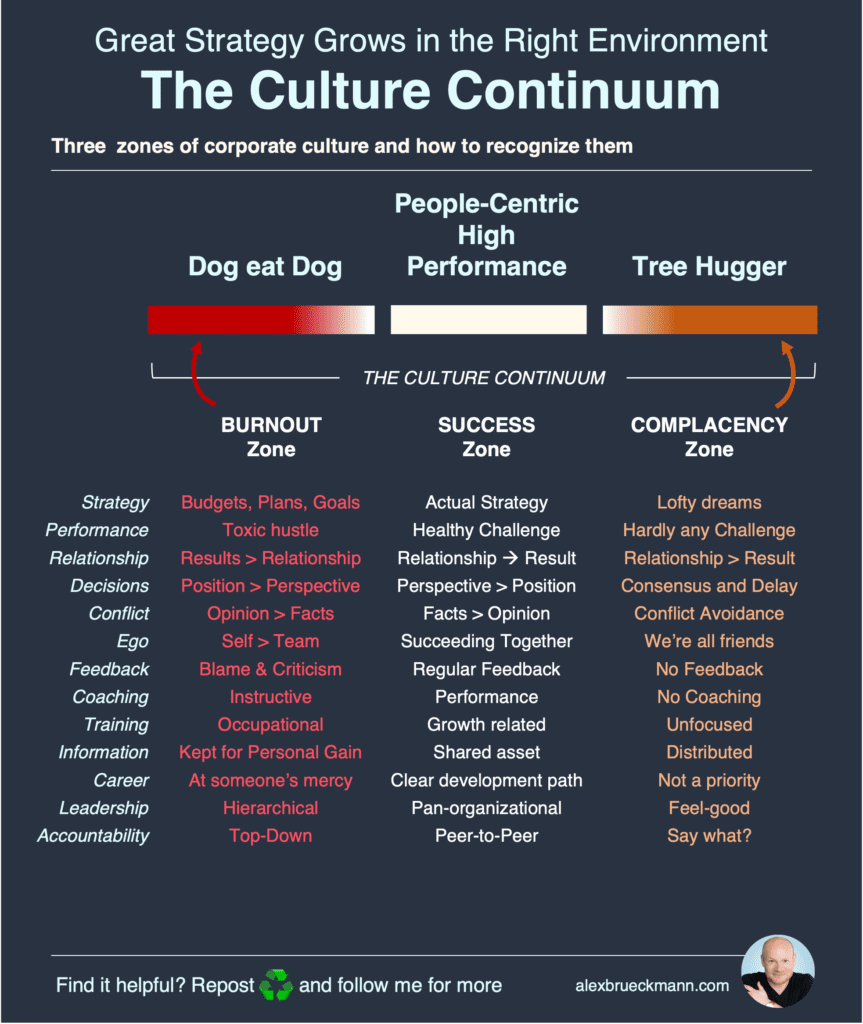The environment in which we design strategy matters more than leaders often realize. The leadership culture, and the wider business culture, dictate the nature of strategy, and its chances of success.
In this article, I introduce you to the Culture Continuum, and I describe why good business strategy can only be cultivated in a people-centric high-performance culture.
The Culture Continuum
In broad terms, there are three distinct types of business culture. They sit on a Culture Continuum ranging from Dog Eat Dog on the left to a Tree Hugger culture on the right. Between the two is the sweet spot: people-centric high-performance culture.

Imagine Dog-Eat-Dog Culture as a toxic environment where people run around with imaginary knifes behind their backs, ready to use them at every opportunity.
A Tree Hugger Culture is the absolute opposite. We are all friends. Imagine kindergarten, but with grown-ups.
A People-Centric High-Performance Culture delivers results, the right way.
Woof Woof
In a Dog-Eat-Dog culture, the focus is skewed towards short-term gains and individual success at the expense of collaboration and long-term sustainability. Budgets, plans, and goals are rigid directives and toxic hustle is in the air.
Relationships take a backseat to results. It is a cutthroat environment where blame is passed around like a hot potato. Feedback is scarce, and coaching is seen as a sign of weakness rather than an opportunity for growth.
Such an atmosphere breeds stress, fights, and toxic behavior. I call this the Burnout Zone. Everyone is on their own, out to get you, with little regard for the collective well-being of the organization.
Cumbaya
On the other end of the Culture Continuum lies the Complacency Zone, the Tree Hugger culture. Lofty dreams create a feel-good atmosphere, but little meaningful action is taken to turn dreams into reality.
There is a reluctance to challenge the status quo or engage in healthy conflict, leading to a lack of innovation and progress.
Decisions are delayed in favor of consensus, and performance feedback is virtually non-existent. With no sense of accountability or direction, employees drift, and organizational goals remain aspirations.
Best of both worlds
Between complacency and burnout lies the Success Zone: People-Centric High-Performance Culture. The focus shifts from individual to collective success.
Strategy is a collaborative process. Healthy challenge replaces toxic hustle. Creativity thrives. Relationships are valued as a pre-requisite of success.
Decisions are made based on facts rather than opinions. Feedback is embraced as a tool for improvement. Coaching is seen as essential for developing talent and maximizing potential.
Leadership is about enabling and empowering others to achieve their full potential. Transparency and accountability play a key role, and everyone takes ownership of their actions and decisions.
Good business strategy needs the Success Zone
A wining strategy is impossible to design in a toxic environment. Strategy is an integrated set of choices to win. In a Dog-Eat-Dog culture, there is little integration or collaboration. In a tree Hugger Culture there is no focus on strategy in the first place.
Integrate executive team development and strategy design for maximum impact.
Only in a people-centric high-performance culture can leaders create true strategy, beyond plans and budgets. This is the main reason why I urge leaders to integrate executive teams development and strategy design into one cohesive approach. The results are better strategy and healthier culture.
Go for it!
📌 Try my free newsletter From the Strategy Room
Join thousands of readers and subscribe here. You’ll get access to 30+ of my most popular info sheets on strategy, leadership, performance, and more.
Main Image by Jay Heike
- Written by: Alex Brueckmann
- Posted on: February 15, 2024
- Tags: business strategy, Culture, leadership, performance

